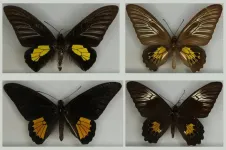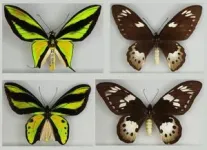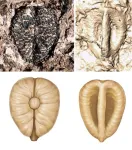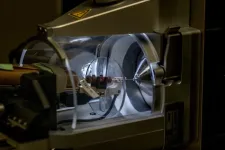(Press-News.org) Pioneering AI-powered research on butterflies has probed the under-studied evolution of females and adds to a debate between the founding fathers of evolution.
The University of Essex study – published in Communications Biology – explores a controversy between Victorian scientists Charles Darwin and Alfred Russel Wallace.
Darwin thought males had more variation, as females often chose mates based on male appearance.
Whereas Wallace thought natural selection across sexes was the biggest factor in difference.
For over a century, scientists have mostly studied males because their differences are more obvious, while females, with more subtle evolutionary changes, had been less studied.
By using high-tech machine learning Dr Jennifer Hoyal Cuthill examined more than 16,000 male and female birdwing butterflies, with collaborators from the Natural History Museum and AI research institute Cross Labs, Cross Compass.
This is the first time the visual differences between sexes have been explored across the species, which live in Southeast Asia and Australasia.
Birdwing butterflies were chosen for this study because of their spectacular wing colour patterns and differences between males and females.
Dr Hoyal Cuthill, from the School of Life Sciences, said: “This is an exciting time, when machine learning is enabling new, large-scale tests of longstanding questions in evolutionary science.
“For the first time we are able to measure the visible extents of evolution to test how much variation is present in different biological groups and among both males and females.
“Machine learning is giving us new information on the evolutionary processes which generate and maintain biodiversity, including in historically neglected groups.”
The study looked at photographs of butterflies from the Natural History Museum collections, which show a range of traits, like wing shapes, colours, and patterns, across several species.
It found that while males often have more distinct shapes and patterns, both males and females contribute to the overall diversity.
The research showed evolutionary patterns predicted by both Darwin and Wallace were found in the butterflies.
Showing that both males and females contribute to diversity among species.
The males showed more variation in appearance, which fits with Darwin's idea that females choose mates based on these traits.
However, the deep learning also found subtle variation in females, matching Wallace's predictions about natural selection allowing diversity in female phenotypes.
Dr Hoyal Cuthill said: “Birdwings have been described as among the most beautiful butterflies in the world. This study gives us new insights into the evolution of their remarkable but endangered diversity.
“In this case study of birdwing butterfly photographs, it is sex that appears to have driven the greatest evolutionary change, including extreme male shapes, colours and patterns.
“However, within the group of birdwing butterflies, we found contrasting examples where female birdwing butterflies are more diverse in visible phenotype than males, and vice versa.
“High visible diversity among male butterflies supports the real-word importance of sexual selection from female mate choice on male variation, as originally suggested by Darwin.
“Cases where female butterflies are more visibly diverse than the males of their species, support an additional, important role for naturally selected female variation in inter-species diversity, as suggested by Wallace.
“Large-scale studies of evolution using machine learning offer new opportunities to resolve debates that have been outstanding since the founding of evolutionary science.”
END
AI-powered study explores under-studied female evolution
The butterfly research adds to a debate between Charles Darwin and Alfred Russel Wallace
2024-07-01
ELSE PRESS RELEASES FROM THIS DATE:
New findings may fix the replicability crisis in microbiome research
2024-07-01
Our bodies are inhabited by trillions of microorganisms, with specific microbes unique to each individual. Through experimentation, scientists have pinpointed certain factors that account for variation in the gut: diet, living conditions, exercise and maternal line. Now, scientists at University of California San Diego have discovered another factor that affects the composition of the gut microbiome: time of day. In fact, the scientists have found that time of day is such an important factor that they’re calling on the National Institutes of Health (NIH) to require researchers ...
Nanorobot with hidden weapon kills cancer cells
2024-07-01
Researchers at Karolinska Institutet in Sweden have developed nanorobots that kill cancer cells in mice. The robot’s weapon is hidden in a nanostructure and is exposed only in the tumour microenvironment, sparing healthy cells. The study is published in the journal Nature Nanotechnology.
The research group at Karolinska Institutet has previously developed structures that can organise so-called death receptors on the surface of cells, leading to cell death. The structures exhibit six peptides (amino acid chains) assembled in a hexagonal pattern.
“This hexagonal nanopattern of peptides becomes a lethal weapon,” explains Professor ...
Largest ever genetic study of age of puberty in girls shows links with weight gain
2024-07-01
Genes can indirectly influence the age at which girls have their first period by accelerating weight gain in childhood, a known risk factor for early puberty, a Cambridge-led study has found. Other genes can directly affect age of puberty, some with profound effects.
In the largest study of its kind to date, an international team led by researchers at the Medical Research Council (MRC) Epidemiology Unit, University of Cambridge, studied the DNA of around 800,000 women from Europe, North America, China, Japan, and Korea.
Published today in Nature Genetics, the researchers found more than 1,000 variants – small changes in DNA – that ...
Sixty-million-year-old grape seeds reveal how the death of the dinosaurs may have paved the way for grapes to spread
2024-07-01
If you’ve ever snacked on raisins or enjoyed a glass of wine, you may, in part, have the extinction of the dinosaurs to thank for it. In a discovery described in the journal Nature Plants, researchers found fossil grape seeds that range from 60 to 19 million years old in Colombia, Panama, and Peru. One of these species represents the earliest known example of plants from the grape family in the Western Hemisphere. These fossil seeds help show how the grape family spread in the years following the death of the dinosaurs.
“These are the oldest grapes ever found in this part of the world, and they’re a few million years ...
AI model finds the cancer clues at lightning speed
2024-07-01
Researchers at the University of Gothenburg have developed an AI model that increases the potential for detecting cancer through sugar analyses. The AI model is faster and better at finding abnormalities than the current semi-manual method.
Glycans, or structures of sugar molecules in our cells, can be measured by mass spectrometry. One important use is that the structures can indicate different forms of cancer in the cells.
However, the data from the mass spectrometer measurement must be carefully analysed by humans to work out the structure from the glycan fragmentation. This process can take anywhere from hours ...
Individuals can tell if their memories are trustworthy, new study shows
2024-07-01
How much trust should we put in our memories? New research shows we have a good awareness of when we are recalling events accurately – and when our brain is filling in gaps with general knowledge.
Memories are a blend of recalled details and ‘prototypical’ information, but a study at the University of Birmingham has shown that when prototypes appear more prominent, we become less confident in the recollection.
This means that we are able to distinguish between these two types of memory, and accurately assess how ...
Palliative care beneficial to manage symptoms, improve quality of life for people with CVD
2024-07-01
Statement Highlights:
Palliative medication management focuses on providing relief from symptoms and enhancing quality of life for people with cardiovascular disease throughout the various stages of the disease.
Decisions about initiating, adjusting or discontinuing cardiovascular and other medicines should be patient-centered and include input from multiple specialties including cardiology experts in close collaboration with primary care professionals.
Evidence shows that adding palliative care interventions to standard cardiovascular ...
How researchers are using digital city-building games to shape the future
2024-07-01
Lancaster University researchers have come up with exciting and sophisticated new mapping technology enabling future generations to get involved in creating their own future built landscape.
They say, in their new research published today, that planners are missing a real trick when it comes to encouraging and involving the public to help shape their own towns, cities and counties for the future.
They also say that games platforms can be used to plan future cities and also help the public immerse themselves in these future worlds.
The researchers have modified Colossal Order’s game ‘Cities: Skylines’ ...
New professorship for Large Engines Research at Graz University of Technology
2024-07-01
Large engines are essential for the global transport and energy sector, powering container ships, locomotives, decentralised power plants and heavy construction machinery. In many areas, battery-powered electric engines are not feasible, which is why the further development of large combustion engines is a key factor for meeting climate protection targets: through greater efficiency, but above all by using new, climate-neutral fuels. In order to strengthen research and the training of specialists in this field, Graz University of Technology ...
Choose where to plant energy crops wisely to minimise loss of biodiversity, says new study
2024-07-01
In the fight to protect biodiversity and limit climate change, the world will reap what it sows, say researchers from the University of Surrey.
Energy crops can be used for heat, electricity and even biofuels like bioethanol. They will become more important as the world transitions away from fossil fuels. In a new study, researchers from Surrey have shown that where you choose to plant energy crops makes a big difference to biodiversity.
A detailed analysis has shown that planting energy crops on existing agricultural land in places like China and Central Europe could minimise harm to biodiversity ...
LAST 30 PRESS RELEASES:
Chicago health information leader recognized for raising CPR readiness and blood pressure awareness
The Intimate Animal, a new book from Kinsey Institute Executive Director Dr. Justin Garcia
When blue-collar workers lose union protection, they try self-employment
New video dataset to advance AI for health care
MEA-based graph deviation network for early autism syndrome signatures in human forebrain organoids
New modeling approach sheds light on rare gut disease
Study documents potentially hazardous flame retardants in firefighter gear
Can certain bacteria regulate aging of the immune system and its related alterations?
AI model helps diagnose often undetected heart disease from simple EKG
There are fewer online trolls than people think
Cell membrane fluctuations produce electricity
Jeonbuk National University study shows positive parenting can protect adolescents against self-harm
Surface-engineered ZnO nanocrystals to tackle perfluoroalkyl substance contamination
This new understanding of T cell receptors may improve cancer immunotherapies
A new fossil face sheds light on early migrations of ancient human ancestor
A new immunotherapy approach could work for many types of cancer
A new way to diagnose deadly lung infections and save lives
40 percent of MRI signals do not correspond to actual brain activity
How brain-inspired algorithms could drive down AI energy costs
Gum disease may be linked to plaque buildup in arteries, higher risk of major CVD events
Contrails are a major driver of aviation’s climate impact
Structure of dopamine-releasing neurons relates to the type of circuits they form for smell-processing
Reducing social isolation protects the brain in later life
Keeping the heart healthy increases longevity even after cancer
Young adults commonly mix cannabis with nicotine and tobacco
Comprehensive review illuminates tau protein's dual nature in brain health, disease, and emerging psychiatric connections
Book prepares K-12 leaders for the next public health crisis
Storms in the Southern Ocean mitigates global warming
Seals on the move: Research reveals key data for offshore development and international ecology
Sports injuries sustained during your period might be more severe
[Press-News.org] AI-powered study explores under-studied female evolutionThe butterfly research adds to a debate between Charles Darwin and Alfred Russel Wallace




